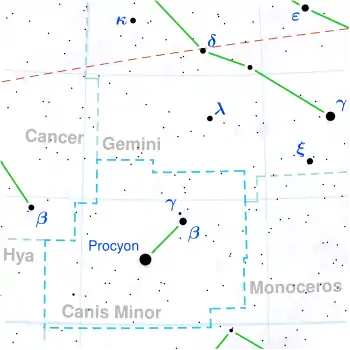 | |
| Observation data Epoch J2000.0 Equinox J2000.0 (ICRS) | |
|---|---|
| Constellation | Canis Minor |
| Right ascension | 07h 32m 05.94912s[1] |
| Declination | +01° 54′ 52.1263″[1] |
| Apparent magnitude (V) | +5.25[2] |
| Characteristics | |
| Spectral type | F0 V[3] or F0 III[4] |
| U−B color index | +0.20[2] |
| B−V color index | +0.22[2] |
| Astrometry | |
| Radial velocity (Rv) | +29.1±2.8[5] km/s |
| Proper motion (μ) | RA: −1.64[1] mas/yr Dec.: −1.10[1] mas/yr |
| Parallax (π) | 4.29 ± 0.27 mas[1] |
| Distance | 760 ± 50 ly (230 ± 10 pc) |
| Absolute magnitude (MV) | −1.59[6] |
| Details | |
| Luminosity | 319[7] L☉ |
| Surface gravity (log g) | 3.64±0.09[8] cgs |
| Temperature | 7,623±86[8] K |
| Metallicity [Fe/H] | +0.15±0.05[8] dex |
| Rotational velocity (v sin i) | 50[9] km/s |
| Other designations | |
| Database references | |
| SIMBAD | data |
Delta1 Canis Minoris, Latinized from δ1 Canis Minoris, is a solitary,[11] yellow-white hued star in the constellation Canis Minor. It is faintly visible to the naked eye with an apparent visual magnitude of +5.25.[2] Based upon an annual parallax shift of 4.29 mas as seen from Earth,[1] this star is located roughly 760 light years from the Sun.
Houk and Swift (1999) list a stellar classification of F0 V[3] for Delta1 Canis Minoris, indicating it is an F-type main-sequence star. However, Cowley et al. (1969) gave it a class of F0 III, which would suggest it is instead an evolved giant star.[4] The spectrum displays a higher than solar metallicity – a term indicating the abundance of elements other than hydrogen and helium compared to the Sun. The star is spinning with a projected rotational velocity of 50[9] km/s and is radiating 319[7] times the Sun's luminosity from its photosphere at an effective temperature of 7,623 K.[8]
References
- 1 2 3 4 5 6 van Leeuwen, F. (2007), "Validation of the new Hipparcos reduction", Astronomy and Astrophysics, 474 (2): 653–664, arXiv:0708.1752, Bibcode:2007A&A...474..653V, doi:10.1051/0004-6361:20078357, S2CID 18759600.
- 1 2 3 4 Johnson, H. L.; et al. (1966), "UBVRIJKL photometry of the bright stars", Communications of the Lunar and Planetary Laboratory, 4 (99): 99, Bibcode:1966CoLPL...4...99J.
- 1 2 Houk, N.; Swift, C. (1999), "Michigan catalogue of two-dimensional spectral types for the HD Stars", Michigan Spectral Survey, 5, Bibcode:1999MSS...C05....0H.
- 1 2 Cowley, A.; et al. (April 1969), "A study of the bright A stars. I. A catalogue of spectral classifications", Astronomical Journal, 74: 375–406, Bibcode:1969AJ.....74..375C, doi:10.1086/110819.
- ↑ de Bruijne, J. H. J.; Eilers, A.-C. (October 2012), "Radial velocities for the HIPPARCOS-Gaia Hundred-Thousand-Proper-Motion project", Astronomy & Astrophysics, 546: 14, arXiv:1208.3048, Bibcode:2012A&A...546A..61D, doi:10.1051/0004-6361/201219219, S2CID 59451347, A61.
- ↑ Anderson, E.; Francis, Ch. (2012), "XHIP: An extended hipparcos compilation", Astronomy Letters, 38 (5): 331, arXiv:1108.4971, Bibcode:2012AstL...38..331A, doi:10.1134/S1063773712050015, S2CID 119257644.
- 1 2 McDonald, I.; et al. (2012), "Fundamental Parameters and Infrared Excesses of Hipparcos Stars", Monthly Notices of the Royal Astronomical Society, 427 (1): 343–57, arXiv:1208.2037, Bibcode:2012MNRAS.427..343M, doi:10.1111/j.1365-2966.2012.21873.x, S2CID 118665352.
- 1 2 3 4 Prugniel, Ph.; et al. (2011), "The atmospheric parameters and spectral interpolator for the MILES stars", Astronomy & Astrophysics, 531: 25, arXiv:1104.4952, Bibcode:2011A&A...531A.165P, doi:10.1051/0004-6361/201116769, S2CID 54940439, A165.
- 1 2 Jasniewicz, G.; et al. (July 2006), "Lithium abundances for early F stars: new observational constraints for the Li dilution", Astronomy and Astrophysics, 453 (2): 717–722, Bibcode:2006A&A...453..717J, doi:10.1051/0004-6361:20054421.
- ↑ "del01 CMi". SIMBAD. Centre de données astronomiques de Strasbourg. Retrieved 2017-09-03.
{{cite web}}: CS1 maint: postscript (link) - ↑ Eggleton, P. P.; Tokovinin, A. A. (September 2008), "A catalogue of multiplicity among bright stellar systems", Monthly Notices of the Royal Astronomical Society, 389 (2): 869–879, arXiv:0806.2878, Bibcode:2008MNRAS.389..869E, doi:10.1111/j.1365-2966.2008.13596.x, S2CID 14878976.
External links
- Kaler, Jim, "Eta and Delta-1 CMi", Stars, University of Illinois, retrieved 22 August 2012